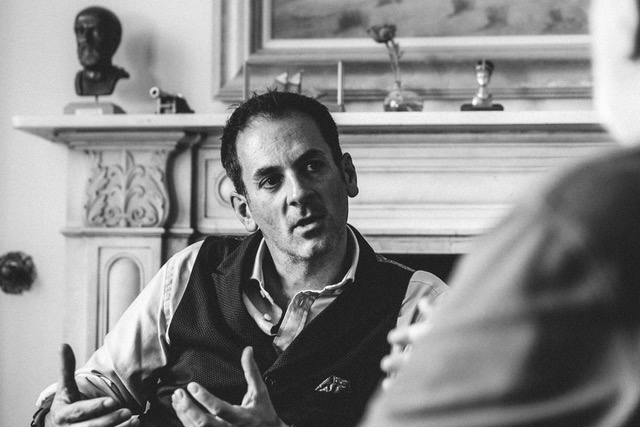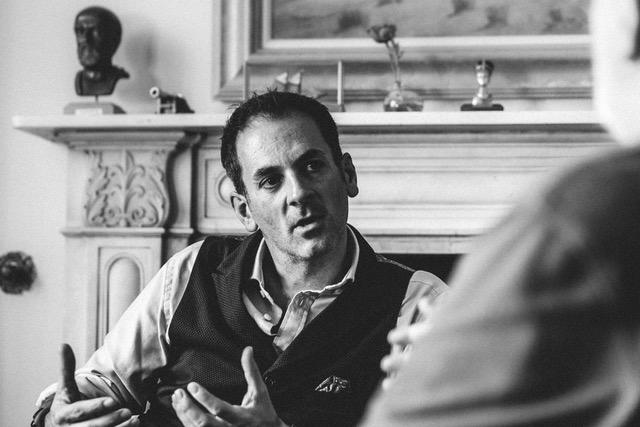Your cart is currently empty!


Many athletes experience this regularly, after intense sports, the body can be left with muscles and joints aching. Runners’s knee is common amongst runners, a real pain in the knee with no injury detected. The notion that aches and pains relate to injury is wrong, they are actually poorly correlated. We discussed with Richmond Stace who is uniquely qualified in pain management. He studied pain science, rehabilitation, nursing, physiotherapy, sport science, and has spent the last decade pioneering pain coaching.
Richmond Stace is also an avid runner himself, running over 100km a week on average, he experiences aches and pains regularly in his muscles and joints, inherent to athletes lives.
Could you tell us a little about your background and how you chose your career path?
It has been a fascinating journey! I trained as a nurse, then read a degree in sports rehabilitation and science, then physiotherapy and then a masters in pain science. Pain grabbed my attention when I was training to be a nurse. This was reignited by lectures from Dr Mick Thacker when I was at Kings College London. At that point, I chose a path that focused on making an impact upon the problem of aches and pains; the number one global health burden.
Why did you become a physiotherapist?
Initially, I was interested in working in the sport, and physiotherapy seemed like a cool job in that field. But then I found that I was making a full circle and returning to my philosophical roots that were laid down during the nurse training: wanting to treat the whole person.
Physiotherapy is more than a job. It is a calling, or indeed a caring. You can make it your own, creating a style and an approach that allows you to use your own straights to help others shape positive futures. It is an incredible opportunity to contribute.
I see a lot of athletes that challenge their bodies every day and struggle with aches and pains as a result. Often they had an injury, which has fully healed but their aches and pains continue. I strive to help them gain their mobility back and enable them to keep pushing their performance.
I understand your technique is very different to the conventional physiotherapy practice, could you explain how and why that is?
My background is probably the biggest factor in my ‘different’ approach. The way I work is informed by all my experiences and training that have been influenced by many great scientists, clinicians, philosophers and coaches. I am very fortunate and grateful for the people who have and do encourage me. In particular Mike Pegg, pioneer of strengths based coaching, and Mick Thacker, who arguably knows more about aches and pains than anyone else on the planet. Both are incredible human beings. You learn much from spending time with such people.
I am very focused on the person and their potential to improve their life. Pain Coaching is the concept I have been pioneering over the past 10 years. Coming through a coaching lens means that I see a person and their needs first. This is the essence of strengths-based and positive coaching, both of which are really styles of being with people. Interweave this with the science of pain, consciousness, perception and other relevant fields to the human experience, and you have a pretty good start point.
How has COVID impacted your practice?
All sessions have been online except for one client who I have been taking out into nature for Trail LIfe sessions (running, walking, breathing, moving, talking, coaching in nature).
I was using online before COVID, so it has been an easy transition. I plan to continue to work this way as there have been many advantages: flexibility on timing, no need for travel and of course no risk of transmission.
However, I am looking forward to seeing people again.
Have you noticed a change in behaviour amongst your patients during this period?
Pretty much all have been very happy to continue to start a programme via video calling. They soon realise that we can work together effectively this way.
Everyone has been affected somehow. However, the focus in our sessions is always upon what the person can do, and in the best ways. With this approach, people begin to see possibilities over problems and opportunities over obstacles. With a new set of tools and practices that build on their existing successful coping strategies, they move forward towards something better.
Are there new techniques or technologies that are hitting the market at the moment?
We often see new products. Some can be useful adjuncts and promote self-care. For instance, balms create the opportunity for touch, which can be incredibly soothing when applied to oneself or by a loved one. TENS machine have been around for some years and can be effective in pain relief.
However, none of these answers the question: why the aches and pains? This is the key question and the answers lie in a proactive approach. Getting better is an active process. This is why understanding your aches and pains and learning practices, tools and strategies are so important. There is no quick fix or pill that can do this work. It is down to the individual who is guided and encouraged by a trained clinician/therapist. Pain is a specialist area.
What kind of sport-related injuries do you come across most often?
The sports injuries I see are those that have not resolved as expected. When people come to see me, their injury has often healed yet their aches and pains continues. This is because aches or pains and injury are poorly related. There are other reasons why aches and pains and sensitivity persist. I listen carefully to what they say to understand why this might be. This informs what we need to do to help the person move on.
What causes them?
There can be an incident such as an ankle sprain, a collision or a fall. Or, there can be something that gradually comes on; a kindling fire. Over time, the impact builds affecting performance. However, each person has their own experience and their own story. There are no pigeon holes or categories; only people.
How can I tell the difference between aches and pains, and a serious injury?
Listen to the person’s story. This provides most of the information: what happened? What is going on for them? What is the impact? What is the most significant challenge for them? What does this mean for them? Why is it important for them to get better? What really matters? What has happened to them in the past that informs their responses now?
What kind of sport-related aches and pains could be avoided with the use of a relief balm?
Sports and being active always results in aches and pains! That is normal. This is the body adapting to the demands. Some people are more sensitive than others and it takes longer to recover. Making sure you figure in this recovery time is vital.
What’s the most soothing way to massage a balm into a sore muscle or joint?
This will be individual. The kind of touch and intent is important. Different types of touch will stimulate different nerve endings. For instance, light stroking will have a different effect compared to massage. The former stimulates our bonding system and shoves the sense of self. The importance of this has been demonstrated in the need for loving touch for children to develop.
You recently discovered the WholyMe Relief Balm and Relief Drops, what do you think of these and who would you recommend these to?
I love the WholyMe concept. I have been using them myself over the past week or so. I must say, the Relief Drops truly contribute to a sense of calm. I also run a lot, about 70-100km per week, so I always have aches and pains, the balm has been helpful in providing relief to my achings muscles and joints. I would recommend this to anyone, simply the act of taking care of yourself through touch with all-natural products can only be beneficial!
What advice do you have for people suffering from chronic or regular aches and pains?
This is a huge question. Any advice has to be individualised according to the person’s needs and what they want to achieve. However, as a general point, I believe that everyone can understand their pain and learn ways to move on and shape a more positive future. There is so much hope and as humans, we have great potential. The role of the coach is to see this potential and help the person see it in themselves.